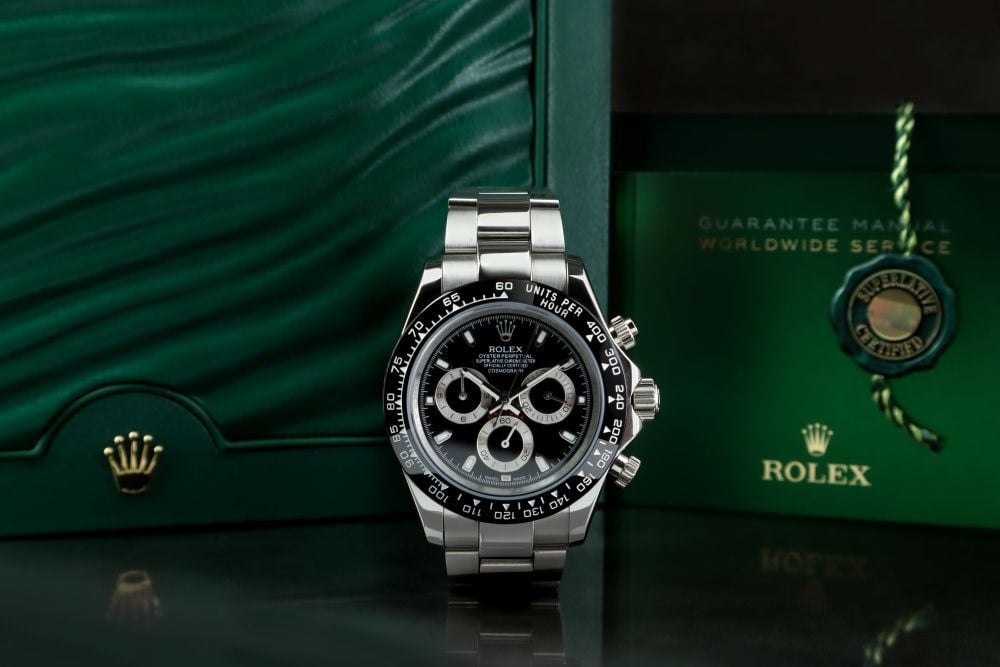The Rolex Daytona: History, Models and Market Value
In the long and often obsessive history of mechanical watches, few names have acquired the sort of mythos attached to the Rolex Daytona. When the Swiss watch house first released the Daytona (known then as the Cosmograph) in 1963, it was a famously slow seller – in part because of its manual-wind movement, the Valjoux 72. Built for the racetrack with its tachymeter bezel and triple subdial, it lacked the flash and elegance of a dress watch and felt too technical for everyday wear.
One of the most important names in the history of the Rolex Daytona is Hollywood legend and racer, Paul Newman. Throughout the ‘60s and ‘70s, Newman wore his Daytona so often that the unusual “exotic” version he sported became known simply as the Paul Newman Daytona. When that same watch sold at auction in 2017 for nearly $18 million, it marked a turning point – transforming the Daytona from a once-overlooked sports watch into a cultural artefact.
Today, the Daytona is less about timing laps and more about cachet – it’s the Rolex with an old-Hollywood aura and a fiercely competitive collector base.

A New Frontier for Rolex – The Race Track
Rolex was founded in 1901, and by the early 1960s, it had already mastered the breadth of professional watches: the Submariner had been tested at depth, the Explorer had gone to Everest, and the GMT-Master had found a home on transatlantic flight decks. What it hadn’t yet mastered was speed. In the postwar decades, car racing was entering something of a golden age: Formula 1 was expanding worldwide and Le Mans was drawing record crowds. It was glamorous, dangerous and highly international – in perfect alignment with the jet-set image Rolex was cultivating.
Introduced as the Cosmograph Reference 6239, the Daytona was aimed squarely at the American racing market. Within a year, the model adopted the “Daytona” name – a nod to the Daytona International Speedway and the 24 Hours of Daytona, which had quickly become fixtures on the motorsport calendar.
Read More: Rolex Watches for Ladies
Beneath the Bezel: The Evolution of the Daytona
For all its cultural significance, the Rolex Daytona remains one of the most technically polished chronographs on the market, and it has stayed largely true to the design language it introduced in the early 1960s. Measuring 40mm, the Daytona is still distinguished by its three subdials at 3, 6, and 9 o’clock (a 30-minute counter, 12-hour counter, and running seconds). It comes in the classic Oyster case with screw-down pushers and crown, framed by a tachymeter bezel – steel on early models, later upgraded to Cerachrom ceramic for durability.
True to its sporting roots, the Daytona doesn’t have a date window and is traditionally paired with the solid-link Oyster bracelet. Adapting to the changing aesthetics of the modern watch market, Rolex began offering select 18-carat gold models with the Oysterflex rubber band in 2017.
Over the years, the Daytona has been powered by three major calibres. The earliest references – including the now-legendary Paul Newman models – were driven by the manually wound Valjoux 72, a widely used Swiss chronograph movement that Rolex modified and finished in-house. In 1988, the brand introduced the reference 16520, marking the first automatic Daytona. It used a heavily reworked Zenith El Primero base –renamed the calibre 4030 – a high-frequency movement that Rolex slowed down and simplified for better reliability and serviceability.
The most significant leap arrived in 2000 with the in-house calibre 4130. Slimmer and more efficient, it reduced the number of parts while extending the power reserve to 72 hours and improving shock resistance. It also brought a small change to the dial: the running seconds subdial moved from 9 o’clock to 6 o’clock, giving the modern Daytona its current configuration.
Read More: Rolex Watches for Men
The Most Famous Rolex Daytonas
Paul Newman’s Daytona
Of all the watches linked to the Daytona name, none carries more cultural weight than Paul Newman’s. When the legendary actor began racing in the late sixties, following his role in Winning, his wife Joanne Woodward gifted him a Rolex Cosmograph with a simple engraving on the caseback: “Drive Carefully – Me.” The watch was a reference 6239, with an off-white dial, contrasting black subdials, and a red outer seconds track – a dazzling layout that would later become known simply as the Paul Newman. In 2017, after falling out of public view for decades, it resurfaced at auction and sold for an extraordinary $17.8 million. It remains one of the most expensive watches ever sold, and arguably the most storied chronograph of the 20th century.
The Rolex Daytona “Rainbow”
First introduced in 2012, the Rainbow Daytona is one of the more divisive models from Rolex – a rare flirtation with flamboyance. Designed under reference 116595RBOW, its bezel is set with 36 multicoloured baguette-cut sapphires, ranging from violet to green to red. In many variants, the hour markers are matched with colour-graded gemstones, with dials in pavé or mother-of-pearl. Inside, the watch is powered by the same calibre as its more utilitarian siblings: the 4130. Produced in very limited runs, the Rainbow is a modern collector’s trophy, favoured by celebrities and sports stars including John Mayer, Harry Kane, and Kevin Hart. On the secondary market, it commands prices upward of $300,000.
The Rolex Daytona “John Player Special”
Nicknamed after the black-and-gold Lotus Formula One livery of the 1970s, the so-called John Player Special is one of the most rare and evocative vintage Daytonas, with fewer than 10 known examples. A reference 6264, it’s crafted in lustrous yellow gold with a black dial and gold subdials, echoing the cigarette brand’s F1 sponsorship era. In 2023, a remarkably well-preserved 18-carat model surfaced after decades in a safety deposit box, kept there by its original owner. When the family released it as part of an estate settlement, it brought in £1,215,000 at Sotheby’s London – a record price for the reference, and a testament to its rarity.
Read More: Most Expensive Watch Brands
Final thoughts
For collectors today, the Rolex Daytona sits at a rare intersection of technical merit, cultural mythology, and enduring market demand. It’s also one of the most competitive to acquire: waitlists for new models can stretch years, with priority going to those with long-standing relationships at authorised retailers. The rarest Daytonas – those defined by provenance, scarcity, or historical weight – seldom appear on the open market, offered instead through auction houses or private client services, such as Sotheby’s.



